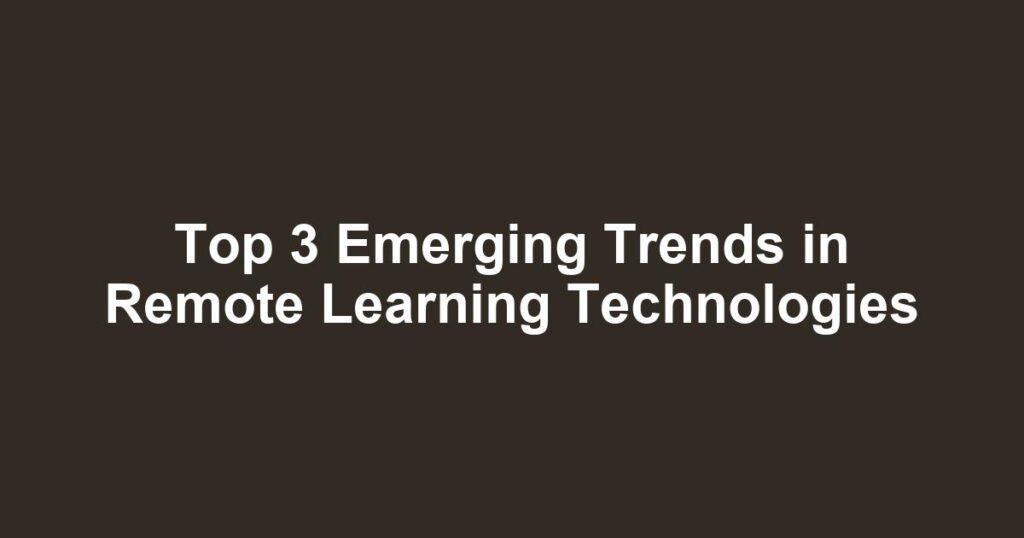Top 3 Emerging Trends in Remote Learning Technologies
The rapid evolution of technology has shaped various aspects of our lives, and education is no exception. With the rise of remote learning, it’s essential to stay updated on the latest trends that enhance the learning experience. As more institutions and businesses adopt remote learning, emerging technologies play a pivotal role in transforming education. In this article, we will explore the top three emerging trends in remote learning technologies you should know about. These innovations are making education more engaging, efficient, and accessible.
1. Artificial Intelligence (AI) and Personalized Learning
Artificial Intelligence (AI) is revolutionizing the way we approach remote learning. By leveraging AI technologies, educators can create personalized learning experiences tailored to individual student needs.
How AI Personalizes Education
AI analyzes student performance data to identify strengths and weaknesses. This information helps educators customize learning paths, ensuring students receive the support they require. Here are some ways AI is enhancing remote learning:
- Adaptive Learning Platforms: These platforms adjust content difficulty based on student progress, providing resources that match their learning pace.
- Automated Assessments: AI can grade assignments and tests quickly, allowing teachers to focus more on instruction and student interaction.
- Chatbots: AI-powered chatbots can answer common student inquiries 24/7, enhancing support outside of traditional learning hours.
Benefits of AI in Remote Learning
Implementing AI in remote learning brings several advantages:
- Enhanced Engagement: Personalized content keeps students engaged and motivated to learn.
- Improved Learning Outcomes: Tailored experiences can lead to better retention and understanding of material.
- Efficient Resource Management: Teachers can allocate more time towards high-impact teaching activities.
2. Virtual Reality (VR) and Augmented Reality (AR)
Virtual Reality (VR) and Augmented Reality (AR) are breaking down barriers in remote education by providing immersive and interactive experiences. These technologies can transport learners to different environments, making complex subjects easier to grasp.
Applications of VR and AR in Education
Remote learning environments can greatly benefit from the use of these technologies in various ways:
- Immersive Learning Experiences: Students can explore historical sites or conduct science experiments in a safe, virtual space.
- Real-World Simulations: VR allows students to practice hands-on skills relevant to their fields, such as medical training or engineering simulations.
- Interactive Learning Environments: AR can overlay digital information onto the real world, enhancing learning through interactive elements.
The Impact of VR and AR on Remote Learning
The incorporation of VR and AR into remote learning brings a host of benefits, including:
- Enhanced Understanding: By visualizing complex concepts, students can better grasp difficult subjects.
- Increased Motivation: Engaging and entertaining learning environments foster student interest and participation.
- Collaboration Opportunities: Students can work together in virtual spaces, even when miles apart, promoting teamwork and collaboration.
3. Learning Management Systems (LMS) with Integrated Features
Learning Management Systems (LMS) are essential tools for remote education, and emerging trends are leading to the development of more powerful and feature-rich platforms. Modern LMS solutions are focusing on integrating innovative technologies that enhance the remote learning experience.
Key Features of Advanced LMS
As education continues to shift online, here are some key features you can expect from modern Learning Management Systems:
- Analytics and Reporting: Advanced analytics tools provide insights into student performance, helping educators make data-driven decisions.
- Seamless Integration with Other Tools: Modern LMS platforms support integration with various educational resources, including AI, VR, and communication tools.
- User-Friendly Interfaces: Intuitive interfaces ensure that both educators and students can navigate the platforms effortlessly, promoting usability.
Why Choose an Advanced LMS for Remote Learning?
Investing in a robust LMS offers numerous benefits, such as:
- Centralized Learning: All course materials, assessments, and communication channels are consolidated in one platform.
- Flexibility: Students can access materials and coursework anytime, accommodating different learning schedules.
- Continuous Improvement: Feedback and analytics provided by the LMS allow for ongoing enhancements to course content and teaching methods.
Conclusion
The landscape of remote learning is continually evolving, driven by technological innovation. By embracing emerging trends like AI, VR, AR, and advanced Learning Management Systems, educational institutions can provide engaging and personalized experiences for students.
If you are an educator, administrator, or a learner navigating remote education, it’s essential to stay informed about these trends. Integrating these technologies into your educational practices can enhance learning outcomes for everyone involved.
Are you ready to embrace the future of remote learning? Start exploring the potential benefits of these technologies today!
For more insightful articles on education and technology, subscribe to our blog and stay updated on the latest trends and innovations in the field!

